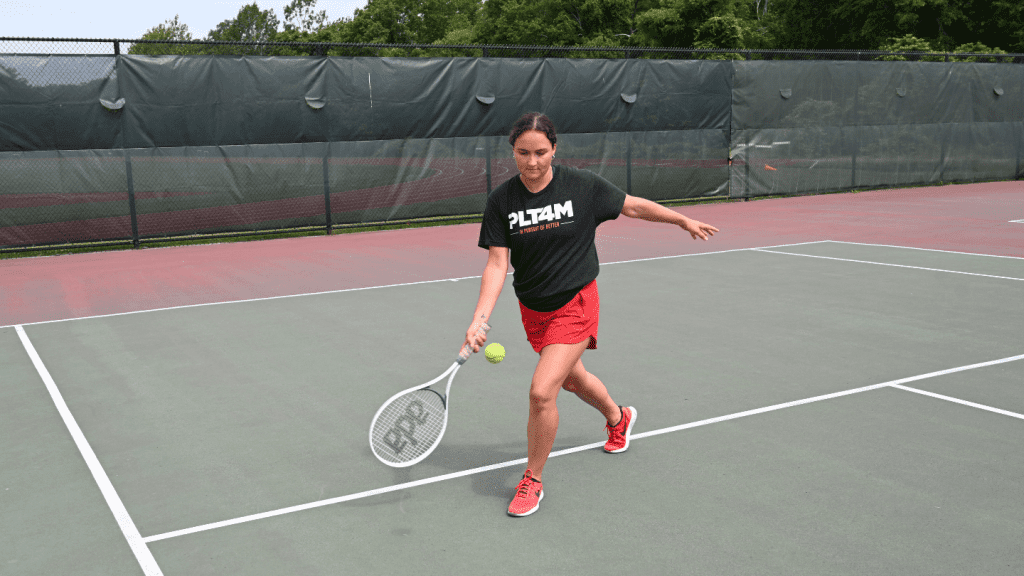Tennis lesson plans aim to provide every student with a foundation in which they can develop their tennis skills, eventually leading to fun and successful gameplay. To do so, students can get comfortable and confident with a breakdown of key areas like forehand, backhand, serve, rallying, and more.
While working on different practice drills, students can also explore the basic rules and strategies of tennis, with an added bonus of different games and activities they can play in groups big or small! Check out awesome resources and activities for your tennis unit.
Skill Development Tennis Lesson Plans
Students who are tennis players outside of physical education might be eager to jump into full blown tennis matches. However, within physical education, regardless of grade level, jumping right to full-blown games of tennis will leave many students in class feeling frustrated and left behind.
Therefore, tennis lesson plans for physical education can focus on skill development. That doesn’t mean teachers can’t create an amazing tennis unit that engages all students in class. Through a skill development approach, teachers can differentiate and modify the fundamental skills of tennis for every experience and ability level.
For example, three simple drills for the forehand groundstroke progress as follows:
Stationary Forehand Groundstroke (Individual): Player bounces ball to themselves and hits a ground stroke over the net.
Stationary Forehand Groundstroke (Partner): Player 1 throws an underhand toss of the ball over the net to player 2 who hits a stationary groundstroke.
Moving Forehand Groundstroke (Partner) – Player 1 throws an underhand toss of the ball to lead player 2 into space so they must practice footwork patterns before hitting the ball.
3 Tennis Drills For Physical Education
Below are three different tennis drills for beginner players in physical education. These tennis drills are from PLT4M and come fully loaded with instructional videos, written notes, and helpful tip ideas.
Our two instructors are Molly Shield and Ally Lima, two physical education teachers that incorporate tennis lesson plans into physical education!
#1 – Stationary Forehand Groundstroke
The goal of this drill is to practice the motion of the forehand both with and without your racket.
Set Up: If practicing with a net, both partners should stand just inside of the service box. This drill only takes up half the tennis court so two groups can practice on one court. If practicing without a net, stand about 15 feet away from each other.
Partner 1: (Thrower)
1) Start with the ball in hand (no racket).
2) Step with opposite foot as throwing hand moves forward.
3) Release the ball between knee and waist level.
4) Follow through to target looking to aim ball so that it bounces in front of partner 2.
Partner 2: (Hitter) – Start in the ready position.
1) Stance: Perpendicular to net (non dominant shoulder facing net).
2) Backswing: Bring racket back towards shoulder height as hips turn in same direction (on a string).
3) Contact: Step towards the ball with non dominant foot making contact out in front at hip height.
4) Follow Through: after contact, continue the swing through the ball and up as if you were scratching your back
#2 – Moving Forehand Groundstroke
Partner 1: (Thrower)
1) Start with the ball in hand (no racket).
2) Step with opposite foot as throwing hand moves forward
3) Release the ball between knee and waist level
4) Follow through to target looking to aim ball so that it bounces in front of partner 2
Partner 2: (Hitter) – Start in the ready position.
All of our same points of performance of our forehand groundstroke apply, but now the hitter must move towards the ball to get into position.
1) Stance: Perpendicular to net (non dominant shoulder facing net)
2) Backswing: Bring racket back towards shoulder height as hips turn in same direction (on a string)
3) Contact: Step towards the ball with non dominant foot making contact out in front at hip height
4) Follow Through: after contact, continue the swing through the ball and up as if you were scratching your back
After hitting the ball, return to the starting position on the center service line and repeat.
#3 – Backhand Groundstroke
Because our backhand stroke requires two hands, we are going to start with a partner bouncing on the same side. You can try to bounce yourself, but we recommend having a partner standing to the side and bouncing the ball so you can set up for your backhand groundstroke during our tennis lesson plans.
The points of performance to the backhand groundstroke are:
1) Stance: Perpendicular to net (dominant shoulder facing net).
2) Backswing: With two hands, bring racket back towards shoulder height as hips turn in same direction (on a string).
3) Contact: Step towards the ball with dominant foot making contact out in front at hip height.
4) Follow Thru: after contact, continue the swing thru the ball and up as if you were scratching your back.
Bonus: Tennis Lesson Plans PDF
While there are lots of great instructional videos for tennis lesson plans, there are also great tennis lesson plans PDF materials. Within the tennis lesson plans PDF content, we break down basic rules of the game, elements of the court, history of the game, and so much more.
Check out a few small samples of the tennis lesson plans PDF content below.
First, if you aren’t ready for a full game of tennis, try some of the other activity suggestions in this PDF:
In addition, check out some of the basic rules, scoring and set up of a tennis court in the following PDF’s:
Key Takeaways On Tennis Lesson Plans
Safety First – There are lots of skills and drills to practice tennis. When in a big class, make sure to always be alert. As beginner tennis players, our goal is to work on accuracy and control, and while we might not be perfect, we don’t want to be smashing the ball and putting people at risk!
3-5 Balls – Our goal in practicing these drills and skills is to get a few practice reps in before switching roles. Try your best to have a handful of balls per group so that you can get a few reps in a row.
Take Your Time – Many of these drills can be practiced for 15-20 minutes or more! For many players, you can spend an entire class working on just forehand, backhand, or any skill. Mix it up to keep things fresh, and always feel free to return to past drills.
FAQ
What other types of lesson plans and workouts does PLT4M have?
Consider PLT4M your full learning management system for health and physical education.
PLT4M has a full slate of PE lessons for physical education teachers to choose from! From PE games to fitness activities, PLT4M has countless options. Check out some of the most popular below:
Is PLT4M aligned to Shape Standards?
Yes, every program is aligned to the PLT4M to the Shape Standards. SHAPE America’s National Standards & Grade-Level Outcomes for K-12 Physical Education define what a student should know and be able to do as result of a highly effective physical education program. This guide demonstrates how the PLT4M programs align with grade level standards, helping you achieve and accomplish a standards-based curriculum.







